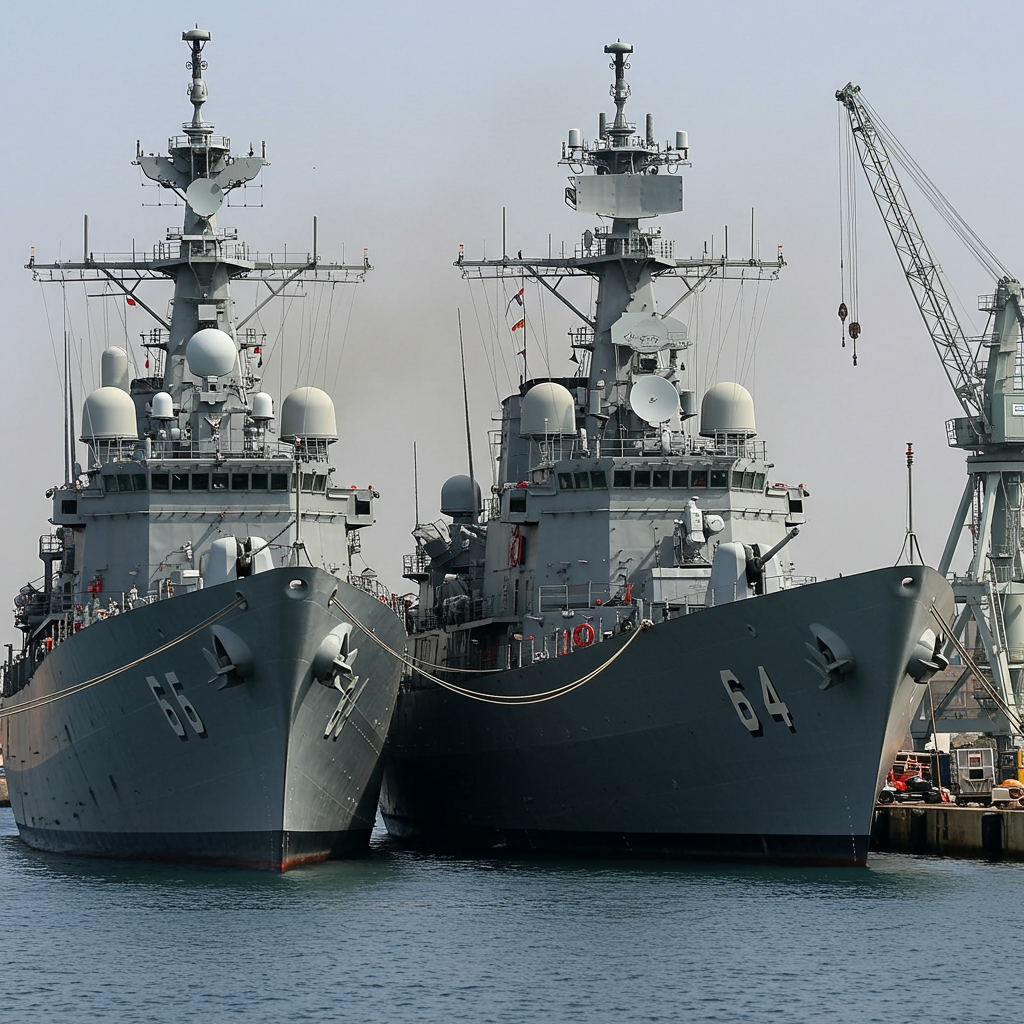Recent israeli aerial assaults against Iran, spanning twelve days from June 12th, significantly impacted various branches of iran’s military, including elements of its naval forces. While air defense systems and sites linked to Iran’s ballistic missile and drone programs within the Islamic Revolutionary Guard Corps (IRGC) formed the core of the Israeli target list, neither the regular Iranian Navy (Nedaja) nor the IRGC Navy (Nedsa) emerged from the intense campaign unscathed.
Initially, during the first two days of the Israeli operation, the Nedaja, particularly vessels based at the key naval hub of Bandar Abbas, largely remained anchored in port. This tactical decision likely stemmed from the understanding that ships alongside are exceptionally vulnerable to aerial attack. Commanders perhaps anticipated Israeli targeting priorities would lie elsewhere, allowing their fleet to avoid direct confrontation.
However, this posture shifted on June 14th. Nedaja ships rapidly departed Bandar Abbas Naval Harbor, home to a significant portion of the Southern Fleet’s primary vessels. They adopted dispersed positions across the sea area stretching between Bandar Abbas and the strategic islands of Qeshm and Hormuz. As of late June, most of these vessels had not returned to port, with only a single Hengam Class landing ship reported back at its base. This extended deployment could serve as a deterrent signal or a show of continued operational capability in the critical Straits of Hormuz.
Evidence on the ground indicated the primary focus of the Israeli air campaign centered on degrading Iran’s air defense network, targeting facilities and personnel involved in nuclear-related research and production, eliminating key IRGC leaders, and striking the IRGC Aerospace Force’s infrastructure for ballistic missiles and drones. Given that the bulk of these objectives fell under the IRGC’s structure, the Nedaja’s initial assessment that they might not be a prime target deck proved largely accurate, though not entirely so.
The broader Iranian Armed Forces (Artesh), which includes the regular Navy, were not entirely exempt from the strikes. In a high-profile incident on June 13th, Major General Mohammad Bagheri, the Artesh Chief of Staff, was assassinated. While also known for his hardline stance, this targeting was likely influenced by assessments of his significant competence compared to potential successors. Other Artesh elements hit included the regular Iran Air Defense Force, which tragically suffered 35 fatalities over the 12-day period, and airbases housing air defense fighter jets across multiple locations including Mehrabad, Tabriz, Hamadan, Isfahan, and Mashhad. Beyond these, it has become clear that the Nedaja was specifically targeted on several occasions.
On June 21st, buildings belonging to the Nedaja’s 1st Naval District in Bandar Abbas were struck. This attack resulted in the deaths of three conscript soldiers. This incident suggests the strike either hit a headquarters building that was minimally staffed at the time or targeted a storage depot. The deceased conscripts were likely guards assigned to secure the facility. Social media reports from the time indicated these targeted locations may have housed armories containing unmanned aerial vehicles and various munitions. Notably, by the time of this strike, the main ships of the 1st Naval District had already departed the nearby naval harbor weeks earlier.
Israeli strategic interest likely focused on elements of Iran’s naval capability perceived to pose a direct or significant threat. This probable target list would include stockpiles of advanced anti-ship missiles, such as the Qadr-380 and Abu Mahdi systems. These missiles boast an impressive range of 650 miles and can be launched from both naval vessels and coastal defense batteries. Israeli forces would also have sought to neutralize Iran’s longer-range naval drones, which the Nedaja has publicly demonstrated can be launched from its warships, posing a potential threat to maritime traffic or regional targets.
The IRGC Navy (Nedsa) appears to have drawn considerably more attention during the Israeli campaign than its regular Navy counterpart. Also on June 21st, the base of the Nedsa’s 5th Naval District, known as Imam Mohammad Bagher, located at Bandar Lengeh, came under attack. This site is considered a potential location for a suspected IRGC coastal cavern, believed to house missile boats. Such hidden caverns have been prominently featured in recent Nedsa propaganda videos. Concurrently, open-source imagery shared by independent analysts showed a warehouse within the Nedsa area of the Bandar Abbas Naval Harbor sustaining damage. The Israeli Defense Forces (IDF) stated this facility was used for storing drones, aligning with the potential targeting of Iranian UAV capabilities.
An intelligence-gathering ship within the same dock area was also reportedly struck by Israeli forces. While some external open-source observers speculated the vessel was the Nedaja intelligence collection frigate IRINS Zagros (H313), the IDF’s description of the target aligns more closely with known Nedsa vessels like the MV Saviz or Behshad, or a sister ship. However, obtaining definitive confirmation of the target vessel’s identity from available up-to-date imagery of their usual berths in the Shahid Bahonar area near Bandar Abbas remains challenging.
As of the latest reporting period, there has been no discernible threat to commercial shipping traffic operating through the strategically vital Straits of Hormuz. Nevertheless, both Nedsa and Nedaja ships remain deployed at sea. Their continued presence and movements in the Straits area likely represent a deliberate display of strength and operational readiness, aimed at projecting the image that Iran’s naval forces, despite the recent strikes, remain a significant entity in the region.
This differential targeting, with Nedsa receiving more attention than Nedaja, underscores Israel’s focus on the IRGC’s asymmetric and potentially more provocative capabilities, like advanced drones and missile storage, compared to the more conventional and often less forward-deployed regular navy. The strikes suggest a precise targeting strategy aimed at degrading specific threat vectors rather than attempting widespread damage to Iran’s entire naval fleet. The casualties among Nedaja conscripts highlight the risk even support or security personnel faced during the intense aerial campaign. While the full strategic impact on Iran’s naval power projection capabilities in the Persian Gulf and beyond will unfold over time, these strikes represent a clear message regarding Israel’s willingness to target Iranian military assets that it deems a direct or indirect threat, regardless of whether they belong to the IRGC or the regular Artesh.
Frequently Asked Questions
What specific Iranian naval forces were targeted by Israeli strikes?
Israeli airstrikes during the recent conflict impacted both branches of Iran’s navy: the regular Navy (Nedaja) and the Islamic Revolutionary Guard Corps Navy (Nedsa). While the Nedsa seemed to receive more attention, both suffered damage and casualties.
Where did these naval strikes take place and what facilities were hit?
Strikes targeting Iranian naval assets occurred primarily in key port areas. Facilities belonging to the Nedaja’s 1st Naval District in Bandar Abbas were hit, resulting in casualties. The Nedsa’s base at Bandar Lengeh was attacked, possibly targeting a suspected missile boat cavern. A warehouse storing drones and an intelligence ship were also struck in the Nedsa area of Bandar Abbas Naval Harbor.
Why might Israel have targeted elements of Iran’s navy during the recent conflict?
Israel likely targeted naval assets identified as posing a direct threat. This included facilities storing advanced anti-ship missiles like the Qadr-380 and Abu Mahdi systems, which have significant range. Additionally, strikes aimed to destroy long-range drones that the Nedaja has demonstrated can be launched from its warships, representing another capability Israel seeks to neutralize.




